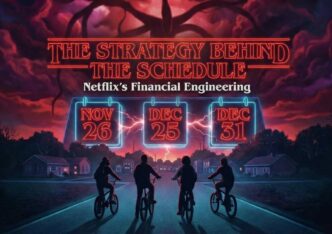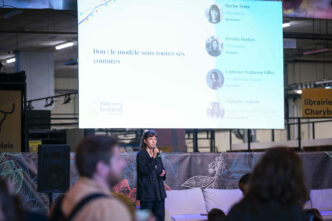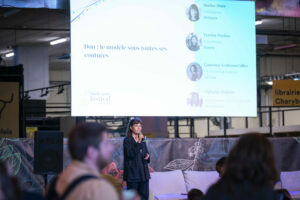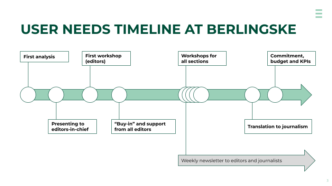
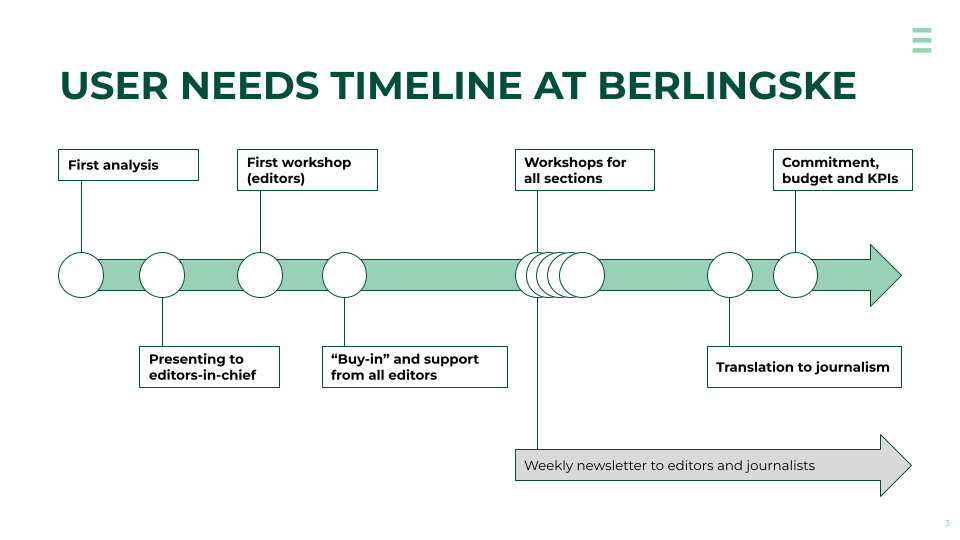
Lars K Jensen is a former journalist who has been working with digital development, analyses and journalism in the media industry for several years. He's currently in charge of Audience, Data and Journalism at Berlingske Media but also publishes content on his blog, Products in Publishing.
Cultural change in the newsroom
Culture eats strategy for breakfast, as the adage goes. And indeed, if you are not aware of culture and how to work with it, your beautifully thought through and well prepared project won’t succeed.
I’ve worked with and into newsroom for 15+ years and in this series I’ll share some of my experiences, learnings and tips plus share and think about what others have done and written.
This is the first article in the series. Enjoy 😊
Executive summary
- User needs are a set of defined needs – I recommend a more general set of needs which you can then break into smaller ones in a sub-layer during analysis, for instance.
- If you know someone working with user needs, don’t ask them what the data showed. Instead, ask them what they learned during analyzing and implementing user needs; what would they not do and what would they happily do all over again?
- Get support and buy-in from top management and find a narrative and stick with it. That’ll decrease the risk that your ideals or the vision of what you are trying to create will change.
- Remain curious and understand what success means to your colleagues. Talk with them as they were your users, find out what motivates them etc.
- Start small. A small, well defined analysis can get you far and will only enrich later conversations on user needs, journalism and user engagement.
- But think about what you want to measure. Pageviews are easy to measure – but easy to dismiss and can easily lead to speculation. Think of adding more qualitative measures and maybe there are some conversions or sign-ups you can add to the mix as well.
- Communicate, communicate, communicate. When executing strategy, communication and data (and access to them) are some of the vital parts. The same goes for driving change and working with culture. Consider doing an internal newsletter.
- Think about where to put the responsibility for user needs. It could be in a bridge role, as that can also decrease the amount of moving parts in the equation – and take some stress of a busy newsroom.
- Make sure that you know why you want to work with user needs.
User needs
If you haven’t really heard about or worked with user needs, it may seem like one of the most hyped parts of journalism right now – and if you’ve followed it since the first inception at the hands of Dmitry Shishkin at the BBC back in 2017 you may see it as one of the strongest and best-lasting trends in the industry.
Whoever you are and however you view user needs, it’s something you need to know about and be familiar with.
In short, user needs is a set of defined needs your users exhibit when consuming news and content. Some publishers use the more established models, like the original BBC model, the Wall Street Journal model (which I’m a fan of and have written about before starting at Berlingske Media) or the 2.0 model, developed by Shishkin and Smartocto, while others build their own – some of them quite specific.
Personally, I prefer to use a broader set of user needs and then have a sub-layer of analytics, where you combine, for instance, a given user need, topic, section and maybe even interaction (like subscriber reads, conversions etc.), and talk about why that specific user need in that specific content or topic either works or doesn’t.
But feel free to use whatever in the equation you want to.
In recent months, ever since I talked about bridge roles and user needs at The Audiencers’ festival in London, I have been asked quite a lot and given more than a few talks on user needs and how we work with them in Berlingske Media – especially Berlingske, the 275 year old newspaper we are named after.
I’ve given talks to publishers, students, management and organizations outside the media and publishing industry – emphasizing how we are going about implementing and continuously working with user needs since I figure that what’s most interesting to hear about.
> You’ll also enjoy: Breaking the silo: bridging editorial and commercial teams, the essentials for success
The right question
Now and then I get the question, “What were the major insights when you looked at the data?”, but to me that’s not the right question to ask. Because those are our insights, and besides not wanting to share our core learnings, every publisher and organization have to do their own analyses and learn their own insights.
It’s always been like that and logically user needs are no different.
Maybe another publisher’s content, audience, value proposition etc. differ from ours (and yours, for that matter), making it risky to copy user needs insights from someone else. I know very well that that hasn’t stopped publishers and news websites from copying each other in the past but it’s quite an important point to remember.
Also, when you copy a user needs model from someone else, you risk copying their way of thinking about journalism, audience, the world etc. (or parts of it), so make sure you think about that.
And always do your own tagging, research, analysis – and learnings.
A much more interesting question is what I – and all us involved in it, really – learned doing the analyzing and implementation processes. And I would say that it was learning how much implementing user needs into a newsroom (or any other organization) is change management which inevitably will see you working with cultural change.
Basically, once you stop “just” using user needs for analysis and actually start to work and publish according to what the insights show you, you are trying to get people to change the way of working they have been following day in, day out for years.
And you need to acknowledge that. And you have to appreciate and enjoy working with that kind of change and culture work, otherwise you probably won’t get very far.
The timeline I usually show when talking about our progress and work with user needs covers roughly a year:

A year of a lot of analysis, workshops and continuous conversations. But more than implementing a system for analysis and production, it’s about cultural change – so roll up your sleeves 😄
That was also the topic when I talked with Journalism.co.uk’s Jacob Granger for an episode of their podcast.
In that talk I gave three examples of advice based on what I’ve learned:
- Get support and buy-in from top management
- Find a narrative and stick to it
- Find out what success means to your colleagues
The first one is pretty basic, that’s change management 101. While talking to Jacob I mention how user needs at Berlingske nearly didn’t happen – if it hadn’t been for our two editors-in-chief.
Finding a narrative is really about storytelling and making sure that you have a common and shared story and look on user needs and how you want to use them to create change for the better. It’s not set in stone, but it’s definitely not something that should change every other week – so make sure it’s based on data and where the publisher and organization actually is headed and want to be.
The third one is probably the most important part of working with other people and trying to create change – whether you are in a bridge role across an organization or not. It also saw it mentioned in a Harvard Business Review article titled How to Lead Across a Siloed Organization, which I recommend you read.
Everyone is talking about our users and customers and how to get to know them in order to build/publish what gives them the most value. But for some reason a lot of us forget to apply that same logic when working with our coworkers.
They have pains, gains and Jobs To Be Done as well – and if you are aware what they are, how they fit into what you are trying to do and you can help them along as well, you are setting everyone up for success.
I recommend asking your colleagues on what motivates and drive them, when they feel they succeed, what they are striving to achieve and what problems they meet. You know, the same kind of question you would ask a user or customer.
When I shared the podcast episode on LinkedIn I added a fourth advice which follows along the same line as the third one above, but I think it’s still worth mentioning:
“Go and meet your colleagues. Don’t just sit on one floor and communicate through email, chat and boring meetings. Go to them, meet them on their home turf – and be honest with them.”
Start small
Another tip I always emphasize in my talks, including last week when I gave a talk to management and the board at a Danish publishing looking into getting started on user needs, is to start small.
Do a limited analysis on existing content; obviously enough to be representative but not so much that you’ll be doing nothing but analyzing for the first couple of weeks.
My first analysis for Berlingske was on three weeks of journalism, published behind their paywall. That was about 750 stories and it took me roughly 12 hours to do.
To me, being a former consultant, that’s a fair upfront investment and gave us clear insights – and actually showed us how Berlingske’s “DNA” looks when seen through user needs: Where are the stories, where are the readers, where are the subscribers, where are the sellers and where are the stories struggling?
Another publisher I spoke to a couple of weeks ago had done what I’ve heard many others do before them: They started out with a huge and lofty conversation on user needs. What is user needs, what are our user needs and how should our journalism change based on our conversations?
Don’t get me wrong, those are important conversations. But if you have them too early on in the process, you don’t actually know enough about your own content and audience to talk about what you want to change – and then you risk that it all fizzles out because it easily becomes a little too fuzzy.
Instead, I would advice you to be more entrepreneurial in your way of thinking. As I wrote in a LinkedIn post on the subject:
“Think like a consultant: You need to make a smaller sale which can both provide value to the customer and show what the tool can do.
After that you can talk bigger projects 😉“
After that first analysis and set of insights you can start the important conversations on what user needs is, how you can use it – and something we spend a lot of the talking about: What is the desired outcome, what future state are you trying to create?
What will you measure?
One of the most important conversations or decisions you should spent at least a little time on before doing your first analysis is what you want to measure. And why you want to measure that in particular.
For instance, if you only measure pageviews, you can easily end up discussing what a pageview actually means, how reliable it really is – and you’ll leave plenty of space for speculation and gut feeling.
Instead, consider if there might be any conversions you can measure. Or more qualitative measure that has to do with actual consumption.
Remember, a pageview largely says something about how an article was marketed and presented – and very little about it’s actual content and performance. That’s why you need to add factors into the mix.
Consider if there are any conversions you can measure. Conversions are great, because they say something about both the content and the user’s intent to get access, sign up for more etc.
More qualitative measures are also a great indicator if the story is interesting to the user and something worth engaging with. A simple pageview measure will never tell you that.
Communicate, communicate, communicate
Sometime last year I read a very interesting Harvard Business Review article titled The Secrets to Successful Strategy Execution. The authors present four basic building blocks which are present when executing strategy in an organization.
But what might surprise you is that which are the most effective.
On a relative score from 0 to 100 the strength, based on other organizations’ experience, looks like this:
- Information (also called information flows): 54
- Decision rights (in Danish we talk a lot about mandate; same thing): 50
- Motivators: 26
- Structure (which you might think is the most important one…): 25
Information has a lot to do with data, and when working with user needs you need to share information about user needs as a model (again and again), data on performance – and repeat the story of where you are trying to go.
As you maybe noticed in the timeline image above, I started sending a weekly newsletter to the editors when we ran the workshops on user needs across Berlingske:

I did that for several reasons. Both to share the insights we gain every week with the most important people in the room.
But also to continuously remind the editors of user needs – and of me and my work and that I’m here to help, obviously 😊.
And it’s been its own little success, actually. Every now and then a journalists emails me asking to be added to the list. They have either heard about my weekly email from their editor or a colleague.
And when busy people out of their own free will genuinely ask for something in their inbox, you know they expect some kind of value from it.
Use bridge roles
How you implement user needs actually has less to do with process and more to do with how you organize it.
Yeah, I know “Trust the process” and all the other mottos, but in my experience it’s much more important to get the right organization around your change, project etc. – and then the best possible process will most likely follow.
It’s very hard to do it the other way around. As I wrote in a previous post in this newsletter:
“The process gets a lot of attention in publisher innovation. It shouldn’t. Focus on culture and structure instead.”
So, how do you organize your user needs implementation? Should you give it to a editor or a select few members of the newsroom? Actually, I would argue that the ultimate (meaning “final” in this context) responsibility should should belong to someone who is slightly outside the newsroom.
Let me explain.
In March 2023, the aforementioned Jacob Granger published an excellent story on Journalism.co.uk on bridge roles in media companies and newsrooms especially; From problem solver to innovator: how bridge roles have evolved in newsrooms.
Having worked in development departments, editorial development teams, product teams and now a commercial department – but almost always into a newsroom – I know what life in a bridge role is like.
In Granger’s article, Dmitry Shishkin – who developed the original user needs model – recommends using bridge roles when implementing user needs in a newsroom:
“‘You need somebody who is good at listening and taking people with them on a journey’ […]
Implementing a user needs strategy often falls to already busy editors, digital editors or audience engagement editors. But having a bridge role dedicated to user needs makes a lot of sense because the strategy cuts right through the organisation: editorial, sales, marketing, data, product and so on.
Having someone skilled at project and change management, Shishkin says, is a must if you want to create a ‘head of user needs’ position.”
Stellar advice.
Having someone outside deeply involved in working with user needs also increases the chance (in my experience) that you will remain true to both your editorial and publicist ideals – and the ideals and future you defined prior to implementation.
This means that for instance the definition of the user needs remains the same and don’t morph during the implementation phases – which would put everything at risk, because your are changing the very foundation which both the analyses and the desired change rest upon.
But getting started on bridge roles isn’t something you just do – but as with other things, it’s not something that should take too long.
When Journalism.co.uk asked a number of people – me included – about their predictions for 2024, I talked about bridge roles and gave four questions, each organization thinking of having people in bridge roles should ask themselves (here in slightly edited form):
- Who and why do we need to connect across our organisation?
- How do we do it?
- Who can do it?
- Are those people in our organisation already?
Start by asking yourself and your colleagues these questions and if user needs are what you are diving into, at least part of the first question should be answered.
As long as you know why you are implementing user needs, right? 😉
That’s all from me this time. I hope you enjoyed reading this and look forward to the next article in this newsletter – and this series.
If you have any questions or ideas, email me at [email protected].
Best regards, Lars

